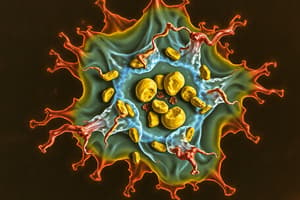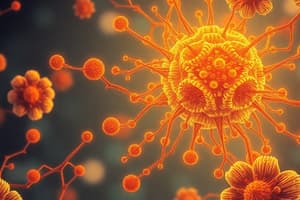Podcast
Questions and Answers
Dendritic cells (DCs) are specialized antigen-presenting cells that capture antigens only through receptor-mediated endocytosis.
Dendritic cells (DCs) are specialized antigen-presenting cells that capture antigens only through receptor-mediated endocytosis.
False (B)
Upon maturation in secondary lymphoid organs, dendritic cells downregulate the expression of major histocompatibility complex (MHC) molecules.
Upon maturation in secondary lymphoid organs, dendritic cells downregulate the expression of major histocompatibility complex (MHC) molecules.
False (B)
Antigen-presenting cells (APCs) include macrophages and T cells.
Antigen-presenting cells (APCs) include macrophages and T cells.
False (B)
Nucleated cells cannot display antigens on their surface via MHC class I molecules.
Nucleated cells cannot display antigens on their surface via MHC class I molecules.
APCs, such as dendritic cells, are particularly efficient in antigen presentation due to their low expression of MHC molecules and co-stimulatory molecules.
APCs, such as dendritic cells, are particularly efficient in antigen presentation due to their low expression of MHC molecules and co-stimulatory molecules.
Combinatorial diversity only refers to the random combination of V and J gene segments during gene rearrangement.
Combinatorial diversity only refers to the random combination of V and J gene segments during gene rearrangement.
Junctional diversity is introduced by the precise joining of gene segments without any insertion or deletion of nucleotides.
Junctional diversity is introduced by the precise joining of gene segments without any insertion or deletion of nucleotides.
The first checkpoint in lymphocyte maturation occurs in secondary lymphoid organs.
The first checkpoint in lymphocyte maturation occurs in secondary lymphoid organs.
Auto-reactivity is a common event due to ineffective mechanisms of central and peripheral tolerance.
Auto-reactivity is a common event due to ineffective mechanisms of central and peripheral tolerance.
Peripheral tolerance involves the recognition of self-antigens by mature lymphocytes in secondary lymphoid organs.
Peripheral tolerance involves the recognition of self-antigens by mature lymphocytes in secondary lymphoid organs.
Peptide binding to MHC molecules is influenced by the anchor amino acids within the peptide sequence.
Peptide binding to MHC molecules is influenced by the anchor amino acids within the peptide sequence.
During the Double-Positive (DP) stage, T cells express both CD4 and CD40 coreceptors.
During the Double-Positive (DP) stage, T cells express both CD4 and CD40 coreceptors.
Individuals always react the same way to identical peptides due to the uniform nature of MHC molecules.
Individuals always react the same way to identical peptides due to the uniform nature of MHC molecules.
Peptide fragments generated from endogenous proteins in the cytosol for display by class I MHC molecules are transported into the Golgi apparatus for binding.
Peptide fragments generated from endogenous proteins in the cytosol for display by class I MHC molecules are transported into the Golgi apparatus for binding.
Single-Positive (SP) stage involves negative selection for self-reactivity.
Single-Positive (SP) stage involves negative selection for self-reactivity.
Antigen processing for display by class II MHC molecules occurs in the cytosol.
Antigen processing for display by class II MHC molecules occurs in the cytosol.
Antigen receptor gene rearrangement is not required for generating diverse repertoire of antigen receptors in T cells.
Antigen receptor gene rearrangement is not required for generating diverse repertoire of antigen receptors in T cells.
The diversity of the peptide repertoire generated from pathogens contributes to individual differences in immune responses.
The diversity of the peptide repertoire generated from pathogens contributes to individual differences in immune responses.
The process of antigen receptor gene rearrangement involves the recombination of V, D, and J gene segments.
The process of antigen receptor gene rearrangement involves the recombination of V, D, and J gene segments.
The Ig Heavy Chain Locus contains V, D, and C gene segments.
The Ig Heavy Chain Locus contains V, D, and C gene segments.
The interactions between the TCR and MHC-peptide complex primarily involve the constant regions of the TCR chains.
The interactions between the TCR and MHC-peptide complex primarily involve the constant regions of the TCR chains.
ITAM stands for Intracellular Tyrosine-based Activation Motif.
ITAM stands for Intracellular Tyrosine-based Activation Motif.
CD4 and CD8 are considered co-receptors because they directly phosphorylate ITAMs upon TCR engagement.
CD4 and CD8 are considered co-receptors because they directly phosphorylate ITAMs upon TCR engagement.
Lck (lymphocyte-specific protein tyrosine kinase) is responsible for modifying ITAM-containing proteins in a T cell.
Lck (lymphocyte-specific protein tyrosine kinase) is responsible for modifying ITAM-containing proteins in a T cell.
HIV binds to CD8 as part of its entry mechanism into CD4+ T cells.
HIV binds to CD8 as part of its entry mechanism into CD4+ T cells.
Costimulators are molecules expressed on the surface of T cells that provide additional signals to APCs to promote their activation and proliferation.
Costimulators are molecules expressed on the surface of T cells that provide additional signals to APCs to promote their activation and proliferation.
CD4 and CD8 are co-receptors that interact directly with MHC class II molecules, enhancing TCR-mediated antigen recognition.
CD4 and CD8 are co-receptors that interact directly with MHC class II molecules, enhancing TCR-mediated antigen recognition.
CLTA-4 and PD-1 are costimulatory molecules expressed on the surface of APCs.
CLTA-4 and PD-1 are costimulatory molecules expressed on the surface of APCs.
IL-2 plays a central role in antigen recognition and T cell activation.
IL-2 plays a central role in antigen recognition and T cell activation.
Each T cell expresses receptors (TCRs) that are specific for multiple antigenic peptides presented by MHC molecules.
Each T cell expresses receptors (TCRs) that are specific for multiple antigenic peptides presented by MHC molecules.
The pre-T cell receptor consists of a β chain and a surrogate α chain.
The pre-T cell receptor consists of a β chain and a surrogate α chain.
The association of CD3 signaling chains (ε, δ, γ) is required for activation and signaling in the pre-T cell.
The association of CD3 signaling chains (ε, δ, γ) is required for activation and signaling in the pre-T cell.
In response to signaling from the pre-T cell receptor, the T cell undergoes apoptosis instead of proliferation and differentiation.
In response to signaling from the pre-T cell receptor, the T cell undergoes apoptosis instead of proliferation and differentiation.
The generation of a large pool of T cells with identical antigen receptors occurs during negative selection in the thymus.
The generation of a large pool of T cells with identical antigen receptors occurs during negative selection in the thymus.
Effector T cells produced in the thymus express CD8 co-receptor.
Effector T cells produced in the thymus express CD8 co-receptor.
T cell maturation involves positive selection for self-reactivity and negative selection for MHC recognition.
T cell maturation involves positive selection for self-reactivity and negative selection for MHC recognition.
Costimulatory molecules, such as CTLA-4 and PD-1, promote T cell activation by inhibiting immune responses.
Costimulatory molecules, such as CTLA-4 and PD-1, promote T cell activation by inhibiting immune responses.
IL-2 is a cytokine that suppresses T cell proliferation and differentiation.
IL-2 is a cytokine that suppresses T cell proliferation and differentiation.
Peripheral tolerance involves the recognition of foreign antigens by mature lymphocytes in secondary lymphoid organs.
Peripheral tolerance involves the recognition of foreign antigens by mature lymphocytes in secondary lymphoid organs.
Junctional diversity is introduced by the random combination of V and J gene segments during gene rearrangement.
Junctional diversity is introduced by the random combination of V and J gene segments during gene rearrangement.
Flashcards
Dendritic Cells (DCs)
Dendritic Cells (DCs)
Specialized antigen-presenting cells that capture antigens via receptor-mediated endocytosis.
MHC Expression in DCs
MHC Expression in DCs
DCs maintain high MHC expression during maturation in secondary lymphoid tissues.
Antigen-Presenting Cells (APCs)
Antigen-Presenting Cells (APCs)
Cells that display antigens to other immune cells. Examples include macrophages and dendritic cells.
MHC Class I Antigen Presentation
MHC Class I Antigen Presentation
Signup and view all the flashcards
Peripheral Tolerance
Peripheral Tolerance
Signup and view all the flashcards
MHC-Peptide Binding
MHC-Peptide Binding
Signup and view all the flashcards
Double-Positive (DP) T cells
Double-Positive (DP) T cells
Signup and view all the flashcards
MHC Molecule Uniformity
MHC Molecule Uniformity
Signup and view all the flashcards
Antigen Processing for MHC Class II
Antigen Processing for MHC Class II
Signup and view all the flashcards
Antigen Receptor Gene Rearrangement
Antigen Receptor Gene Rearrangement
Signup and view all the flashcards
T Cell Receptor Diversity
T Cell Receptor Diversity
Signup and view all the flashcards
Single-Positive (SP) T cells
Single-Positive (SP) T cells
Signup and view all the flashcards
Lck (Lymphocyte-Specific Protein Tyrosine Kinase)
Lck (Lymphocyte-Specific Protein Tyrosine Kinase)
Signup and view all the flashcards
CD4, CD8 Coreceptors
CD4, CD8 Coreceptors
Signup and view all the flashcards
Costimulatory Molecules (CTLA-4, PD-1)
Costimulatory Molecules (CTLA-4, PD-1)
Signup and view all the flashcards
IL-2's Role in T cells
IL-2's Role in T cells
Signup and view all the flashcards
T Cell Antigen Receptor Specificity
T Cell Antigen Receptor Specificity
Signup and view all the flashcards
Pre-T cell Receptor
Pre-T cell Receptor
Signup and view all the flashcards
CD3 Signaling Chains
CD3 Signaling Chains
Signup and view all the flashcards
Negative Selection in Thymus
Negative Selection in Thymus
Signup and view all the flashcards
Effector T Cells, Maturation
Effector T Cells, Maturation
Signup and view all the flashcards
T Cell Maturation, Selection
T Cell Maturation, Selection
Signup and view all the flashcards
Costimulatory Molecules (CTLA-4, PD-1)
Costimulatory Molecules (CTLA-4, PD-1)
Signup and view all the flashcards
IL-2, T Cell Role
IL-2, T Cell Role
Signup and view all the flashcards
Peripheral Tolerance
Peripheral Tolerance
Signup and view all the flashcards




